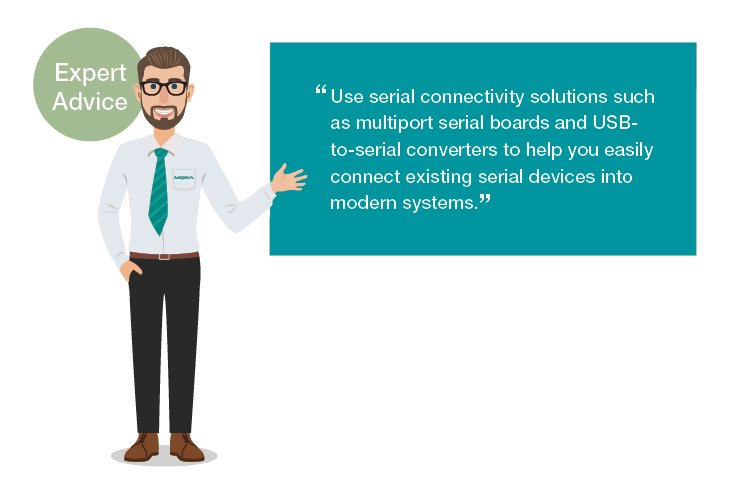
When a machine or serial device has been running for decades and helping a business grow, the question may arise: how long will it last? Computers are no longer equipped with COM ports, operating systems are updated more often and become more diverse. In addition, modern companies are trying to increase the efficiency of business management. To do this, they seek to manage devices online, get information immediately, minimize response times, and generate more data for business intelligence.
All of these things come down to how easy it is to connect devices. And there are two questions here:
- How can your equipment connect to modern systems if serial ports are no longer available as a standard interface in new computers?
- How can devices be controlled remotely if they do not have Ethernet ports?
Modern production equipment and monitoring sensors have been upgraded with Ethernet interfaces. On the one hand, this simplified the connection and increased the efficiency of data collection. On the other hand, replacing all the old equipment means a huge investment.
What if upgrading doesn't have to be expensive?
Keeping legacy serial devices in service is necessary not only for sentimental reasons, but also to protect investments by expanding the capabilities of once purchased equipment. There are many solutions for connecting serial devices to modern networks. And most importantly, they are simple and affordable.
In this article, we'll highlight three major challenges that engineers face when trying to upgrade serial networks. We also provide expert advice to make it easier for you to upgrade..
Issue #1
Modern computers don't have serial ports by default anymore.
In industry, computers are used to interact with network devices. However, RS-232, RS-422 and RS-485 interfaces are currently only found on specialized computers. This makes it difficult to connect serial devices in the field to control centers. Fortunately, the problem can be fixed with PCI, PCIe, mini-PCIe format motherboard expansion cards. They are inserted into the computer and add the number of serial ports.
An alternative solution is to use Universal Serial Bus (USB) ports, as they are standard on any modern computer or laptop. There are dedicated serial to USB converters for this approach.

Issue #2
Serial interfaces make remote monitoring difficult
When applications reach a certain scale, providing remote control based on serial interfaces becomes more difficult, but at this point it is most needed. Most projects use the Ethernet standard for remote monitoring. Therefore, serial Ethernet servers are an economical option for connecting older devices to distributed networks.
Converting data from serial interfaces to the Ethernet standard format can cause some difficulties due to different network architectures and software. It may be necessary to redesign the original program to work with a serial interface in order to use this new communication interface and data interpretation. For example, create virtual COM ports to access serial devices over TCP/IP based networks. In addition, converting serial protocols such as Modbus RTU to Ethernet standard protocols such as Modbus TCP requires additional steps.
If you want to integrate your serial devices into Ethernet-based systems, choose a serial interface server to help keep setup effort to a minimum and save you a lot of time. Also, make sure the server comes with driver support that matches your preferred operating system.

Issue #3
Equipment EOL risks
We have already found out that the life of old assets can be extended with additional solutions. However, in the long run, the fact that the manufacturer does not unexpectedly discontinue the product is of the greatest importance. Therefore, the choice of supplier of components is of key importance. It depends on it whether you can replace the equipment with a similar one in a few years during maintenance.
In addition, as technology advances, so do new challenges. Therefore, the solutions you choose must keep up with the changes. For example, cyberattacks are increasingly becoming a serious threat to businesses. Cyber security features are now critical when choosing any devices with network interfaces. If you want to have guarantees for the protection of solutions and business in the long term, choose those equipment manufacturers that guarantee a long life cycle of products and the constant introduction of new technologies.

Your trusted partner for serial solutions
Your trusted partner for serial solutions
Moxa's serial solutions solve all these problems. They make it easy to connect serial devices.
Our serial product range includes:
- multiport serial cards
- USB-to-serial converters
- serial device servers
- serial-to-Ethernet protocol gateways
Our solutions meet the requirements described above for connecting serial devices to modern systems. MOXA equipment supports many operating systems with their latest versions, including Windows, macOS and Linux.
Moxa has been providing daisy chain solutions for over 30 years. We are committed to providing products that will meet your future networking requirements over the next decades.

